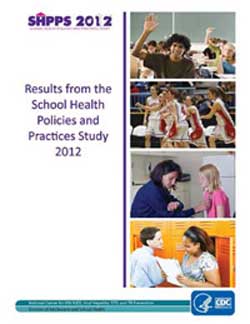SHPPS Results
The most recent results available are from state-and district-level data collected during 2012. In 2014, SHPPS collected school- and classroom-level data; results will be available in the summer of 2015. PDF files on this page range from 323K to 2.5M.
Encouraging Trends in School Health Policies infographic
Results from the School Health Policies and Practices Study 2012

Chapter 1: Background and Introduction
Chapter 2: Methods
Chapter 3: Health Education
Chapter 4: Physical Education and Physical Activity
Chapter 5: Health Services
Chapter 6: Mental Health and Social Services
Chapter 7: Nutrition Services and the School Nutrition Environment
Chapter 8: Safe and Healthy School Environment
Chapter 9: Physical School Environment
Chapter 10: Faculty and Staff Health Promotion